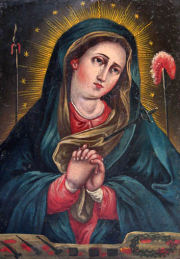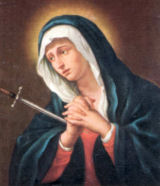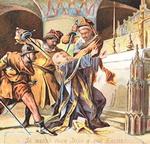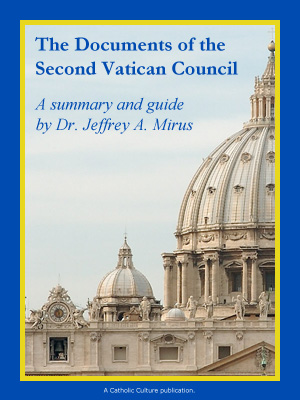Month of the Seven Sorrows of Mary
The month of September (Overview - Calendar) is dedicated to the Seven Sorrows of Mary. Devotion to the sorrows of the Virgin Mary dates from the twelfth century, when it made its appearance in monastic circles under the influence of St. Anselm and St. Bernard. The Cistercians and then the Servites undertook to propagate it. It became widespread in the fourteenth and especially the fifteenth centuries, particularly in the Rhineland and Flanders, where Confraternities of the Sorrowful Mother sprang up. It was in this context that the first liturgical formularies in her honor were composed. A provincial council of Mainz in 1423 made use of these in establishing a "Feast of the Sorrows of Mary" in reparation for Hussite profanations of her images.
In 1494 the feast appeared in Bruges, where the Precious Blood of Christ was venerated; later on it made its way into France. It did not, however, become widespread in France before Benedict XIII included it in the Roman Calendar in 1727 and assigned it to the Friday before Palm Sunday.
Some Churches had previously celebrated this feast during the Easter season. Others, however, celebrated the Joys of the Blessed Virgin during the Easter season, as is still done today at Braga. In some places it was entitled "Recollection of the Feasts and Joys of the Blessed Virgin Mary."
Excerpted from The Church at Prayer, Vol. IV A.G. Martimort.
 God vouchsafed to select the very things about Him which are most incommunicable,
and in a most mysteriously real way communicate them to her. See
how He had already mixed her up with the eternal designs of creation,
making her almost a partial cause and partial model of it. Our Lady's
co-operation in the redemption of the world gives us a fresh view
of her magnificence. Neither the Immaculate Conception nor the Assumption
will give us a higher idea of Mary's exaltation than the title of
co-redemptress. Her sorrows were not necessary for the redemption
of the world, but in the counsels of God they were inseparable from
it. They belong to the integrity of the divine plan. Are not Mary's
mysteries Jesus' mysteries, and His mysteries hers? The truth appears
to be that all the mysteries of Jesus and Mary were in God's design
as one mystery. Jesus Himself was Mary's sorrow, seven times repeated,
aggravated sevenfold. During the hours of the Passion, the offering
of Jesus and the offering of Mary were tied in one. They kept pace
together; they were made of the same materials; they were perfumed
with kindred fragrance; they were lighted with the same fire; they
were offered with kindred dispositions. The two things were one
simultaneous oblation, interwoven each moment through the thickly
crowded mysteries of that dread time, unto the eternal Father, out
of two sinless hearts, that were the hearts of Son and Mother, for
the sins of a guilty world which fell on them contrary to their
merits, but according to their own free will.
God vouchsafed to select the very things about Him which are most incommunicable,
and in a most mysteriously real way communicate them to her. See
how He had already mixed her up with the eternal designs of creation,
making her almost a partial cause and partial model of it. Our Lady's
co-operation in the redemption of the world gives us a fresh view
of her magnificence. Neither the Immaculate Conception nor the Assumption
will give us a higher idea of Mary's exaltation than the title of
co-redemptress. Her sorrows were not necessary for the redemption
of the world, but in the counsels of God they were inseparable from
it. They belong to the integrity of the divine plan. Are not Mary's
mysteries Jesus' mysteries, and His mysteries hers? The truth appears
to be that all the mysteries of Jesus and Mary were in God's design
as one mystery. Jesus Himself was Mary's sorrow, seven times repeated,
aggravated sevenfold. During the hours of the Passion, the offering
of Jesus and the offering of Mary were tied in one. They kept pace
together; they were made of the same materials; they were perfumed
with kindred fragrance; they were lighted with the same fire; they
were offered with kindred dispositions. The two things were one
simultaneous oblation, interwoven each moment through the thickly
crowded mysteries of that dread time, unto the eternal Father, out
of two sinless hearts, that were the hearts of Son and Mother, for
the sins of a guilty world which fell on them contrary to their
merits, but according to their own free will.
— Fr. Frederick Faber, The Foot of the Cross.








